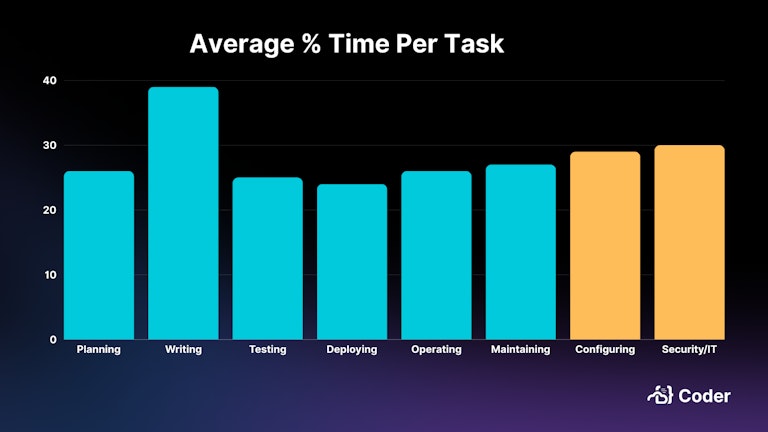Introducing Cloud Development Environments to Your Enterprise
An enterprise has a lot to gain by adopting an enterprise-wide, managed CDE platform

Cloud development environments (CDE) are popular among students, hobbyists, and small- to medium-sized businesses. They don’t have the time or expertise to set up their development environments before they can even edit the first file. So they turn to platforms like Replit and StackBlitz to start coding quickly, typically in minutes, often on modest hardware. These platforms leverage the cloud to give these developers turnkey configurations, automatically-provisioned compute and storage, easy collaboration, and other features.
Enterprise development organizations are realizing that they can also gain from a platform to manage their CDEs. Industry analysts Gartner and Redmonk confirm this growing interest and investment. Closer to the ground, at Coder we’ve been helping our enterprise customers roll-out CDEs to thousands of developers across a wide range of industries, from banking to drones.
Enterprise teams have the same problems, only bigger and more complex
Your enterprise probably wrestles with these situations:
- Onboarding: Developers follow giant tutorials and fill out tickets to set up their environments.
- Dependencies: Dozens, more likely hundreds, of dependencies to manage.
- Build times: Hundreds, probably thousands, of files to check out, index, and compile.
- Security/IT compliance: These take up developer time that would otherwise be spent on actual software development.
- Hardware: High-performance or exotic hardware either sits idle or is overstretched.
- Collaboration: Heterogeneous teams, like developers, testers, and deployers, work on the same projects.
- Geography: Teams and the people in them are spread among several time zones.
- Build vs buy: We’ve seen customers spend more to maintain an in-house CDE platform than they would spend on an managed enterprise solution with more features.
The teams in your enterprise might also be spending too much time on non-development activities. We commissioned a survey of 223 enterprise organizations about where their developers spend their time. They report spending as much or more time on configuring their development environments and complying with security and IT policies as they do tasks like planning, coding, and testing.

Productivity engineering is a balancing act
Enterprise organizations manage these bigger problems by dedicating staff to productivity engineering. They make sure that development teams have what they need to get work done.
It’s a balancing act:
- To solve friction points like slow laptops or complicated onboarding, a productivity engineering team takes a product management approach for quick wins.
- That puts them at odds with the top-down efforts that they’re also responsible for, like consolidating languages and services.
Then there the challenges of doing more with less:
- Change the core workflows and habits of developers they don't control.
- Work with limited or even shrinking resources.
Productivity engineering teams land in a position where they are more likely to focus on squeezing more value out of existing solutions. Any effort to invest in substantial, sustainable improvement seems like a risk. In other words, keeping the status quo feels like a safe bet.
The result: Enterprise organizations invest little in improving developer flow because the complications of their myriad official development environments seem like barriers to adopting a managed CDE platform.
In fact, at Coder we’ve seen that the opposite is true.
The costs and benefits of a managed CDE platform
What many enterprises don't realize is that adopting a managed CDE platform lets them incorporate best practices at the very beginning of the software development lifecycle. This leverage frees up a productivity engineering team’s time to improve the other issues that development teams face. And they can do this systematically and confidently.
Developer experience is, by nature, impossible to define. We believe that improving developer flow starts from the IDE, where developers should spend most of their time. Unlike other tools, we’ve seen how a successful CDE platform roll-out can have a measurable, direct impact on developer satisfaction.
A successful roll-out pays off in the long term too. Once they’ve adopted managed CDE platform, an enterprise is in an excellent position reach goals like these:
- Faster developer onboarding
- Substituting costly in-house developer solutions
- Standarding legacy system access
- Higher compliance to security and IT policies
A foundation for continuous improvements
It’s almost impossible for an enterprise to make a confident decision to adopt a CDE without the proper knowledge. There isn’t a lot of guidance out there.
We’ve helped big enterprise development organizations adopt a managed CDE platform as the foundation to improve developer flow. With the right metrics, planning, and communication, we’ve seen our customers get big benefits, bigger than they (or we!) expected.
We’ve put this all together into a whitepaper to help your enterprise do the same. You can learn, step-by-step, how to research, build a business case, plan, implement, and measure the adoption of a managed platform for the CDEs in your enterprise. Download the whitepaper here.
Related Content:
CDEs Are Going to Live Up to the Hype
Subscribe to our newsletter
Want to stay up to date on all things Coder? Subscribe to our monthly newsletter and be the first to know when we release new things!


